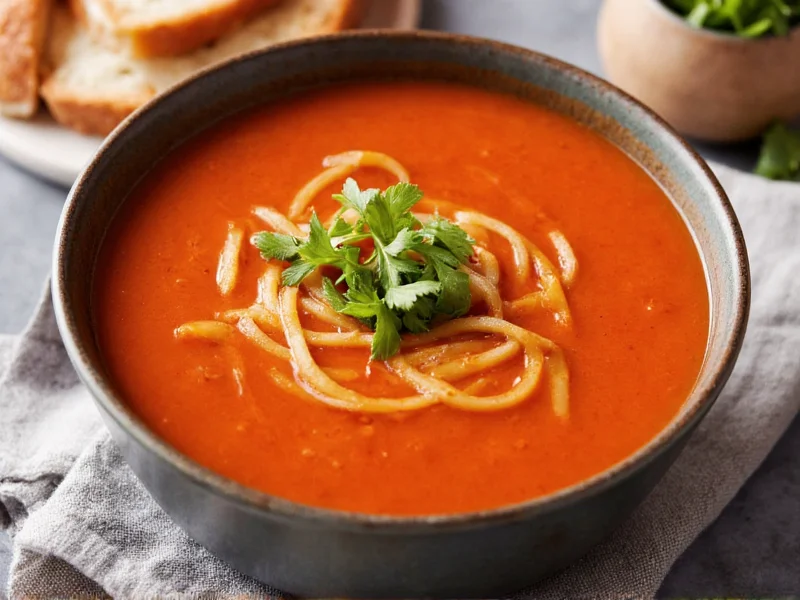When searching for the perfect tomato soup, understanding what makes one option superior to another is essential. The ideal tomato soup delivers a harmonious blend of sweet and tangy flavors with a velvety texture that coats the spoon without being overly thickened. Whether you're selecting a store-bought variety or preparing your own, several key factors determine quality that go beyond simple brand recognition.
What Defines Exceptional Tomato Soup
Tomato soup quality hinges on three critical elements: ingredient integrity, flavor balance, and texture. Premium tomato soups use ripe, flavorful tomatoes as their foundation—ideally San Marzano or other plum varieties known for their rich taste and lower acidity. The best options avoid high-fructose corn syrup and artificial thickeners, instead relying on natural ingredients like roasted onions, garlic, and fresh herbs to build complexity.
Professional chefs emphasize that the acid-sweet balance makes or breaks tomato soup. Too much acidity creates a harsh bite, while excessive sweetness masks the tomato's natural character. The finest tomato soups incorporate subtle sweet elements like roasted carrots or a pinch of sugar to counterbalance acidity without creating dessert-like profiles.
Top Store-Bought Tomato Soup Analysis
Not all commercial tomato soups deliver equal quality. Our evaluation considered ingredient lists, flavor profiles, texture, and versatility across multiple blind taste tests. The following brands consistently demonstrated superior characteristics:
| Brand | Key Strengths | Considerations | Best For |
|---|---|---|---|
| Amy's Organic Tomato Bisque | Rich tomato flavor, organic ingredients, no artificial additives | Slightly higher sodium content | Daily consumption, gluten-free diets |
| Pacific Foods Organic Creamy Tomato | Velvety texture, balanced acidity, coconut milk base | Contains coconut milk (allergy consideration) | Dairy-free diets, creamy texture preference |
| Campbell's Well Yes! Tomato | Lower sodium, recognizable brand, vegetable-forward | Less intense tomato flavor | Everyday pantry staple, moderate health focus |
| Windsor"s Organic Tomato Basil | Artisanal quality, small-batch production | Higher price point, limited availability | Special occasions, gourmet preference |
Homemade vs. Store-Bought: Making the Right Choice
While premium store-bought options provide convenience, homemade tomato soup generally offers superior flavor when prepared with care. The difference between adequate and exceptional homemade tomato soup often comes down to technique rather than complexity.
Professional chefs recommend starting with high-quality canned San Marzano tomatoes (look for DOP certification) rather than fresh tomatoes except during peak summer season. The secret to restaurant-quality texture lies in proper emulsification—blending hot soup requires caution to avoid splatters, while immersion blenders create smoother results with less effort.
For those seeking the best canned tomato soup for quick meals, Pacific Foods Organic stands out for its clean ingredient profile and rich mouthfeel. When evaluating healthy tomato soup options without cream, Amy's Organic provides satisfying depth through vegetable broth and olive oil rather than dairy.
Elevating Store-Bought Tomato Soup
Even excellent commercial tomato soups can benefit from simple enhancements. These professional techniques transform good soup into exceptional:
- Add umami depth: Stir in 1-2 teaspoons of tomato paste cooked in olive oil before adding soup
- Brighten flavors: Finish with fresh basil or a squeeze of lemon juice just before serving
- Improve texture: Blend 1/4 of the soup then mix back in for enhanced mouthfeel
- Balance acidity: Add a small pinch of baking soda (1/16 teaspoon) if too tart
For those exploring the best tomato soup recipes for beginners, start with a quality store-bought base and incorporate one enhancement at a time to understand flavor development. This approach builds culinary confidence while delivering immediate improvements.
Special Dietary Considerations
Dietary restrictions shouldn't compromise tomato soup quality. For dairy-free versions, coconut milk creates creaminess without altering the fundamental tomato profile. Those following low-sodium tomato soup options should look for brands with under 400mg per serving or prepare homemade versions using no-salt-added tomatoes and building flavor through roasted vegetables.
Gluten-free consumers should verify that creamed tomato soups use cornstarch or other gluten-free thickeners rather than wheat flour. Many premium organic brands now clearly label gluten-free status, making selection easier for those with dietary restrictions.
Avoiding Common Tomato Soup Mistakes
Even experienced cooks make critical errors with tomato soup. The most frequent issues include:
- Overcooking fresh herbs: Add delicate herbs like basil at the very end
- Incorrect acid balance: Adjust sweetness/acidity after soup has cooled slightly
- Improper blending technique: Never fill blender more than halfway with hot liquid
- Ignoring temperature effects: Flavor perception changes significantly between hot and warm temperatures
Understanding these pitfalls helps identify what makes good tomato soup stand out from mediocre versions. The finest tomato soups demonstrate attention to these details through balanced flavor and perfect texture.
Seasonal Adaptations for Year-Round Enjoyment
Tomato soup excellence varies by season. During summer's tomato peak, fresh varieties shine in chilled gazpacho-style preparations. For winter comfort, roasted tomato versions with deeper caramelized notes provide satisfying warmth. The best tomato soup for cold weather typically includes roasted garlic and a touch of smoked paprika for complexity.
When selecting the best store-bought tomato soup for camping, shelf-stable options in aseptic packaging maintain quality without refrigeration. Look for brands using tetra-pak containers rather than traditional cans to avoid metallic aftertastes.
Final Recommendations Based on Need
The "best" tomato soup depends on your specific requirements:
- For everyday convenience: Pacific Foods Organic Creamy Tomato
- For health-conscious eating: Amy's Organic Tomato Bisque
- For gourmet experience: Homemade with San Marzano tomatoes and fresh basil
- For dietary restrictions: Choose based on specific needs (gluten-free, dairy-free, low-sodium)
When evaluating top-rated tomato soup brands by food critics, consistency across multiple review sources indicates genuine quality rather than marketing influence. The most frequently recommended options demonstrate reliable flavor profiles and ingredient integrity across seasons.











 浙公网安备
33010002000092号
浙公网安备
33010002000092号 浙B2-20120091-4
浙B2-20120091-4